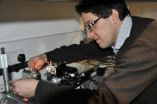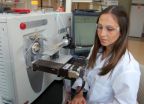(Press-News.org) Southampton researchers have demonstrated that mothers who have higher levels of n-6 polyunsaturated fatty acids (PUFAs), which are found in cooking oils and nuts, during pregnancy have fatter children.
The study, carried out by the Medical Research Council (MRC) Lifecourse Epidemiology Unit, University of Southampton, assessed the fat and muscle mass of 293 boys and girls at four and six years, who are part of the Southampton Women's Survey (SWS), a large prospective mother-offspring cohort.
Their assessments were compared to the concentrations of PUFAs which were measured in blood samples collected from their mothers during pregnancy.
The study, published in the January edition of Journal of Clinical Endocrinology and Metabolism, found that children who were born to mothers who had had greater levels of n-6 PUFAs during pregnancy had greater fat mass.
Dr Nicholas Harvey, Senior Lecturer at the MRC Lifecourse Epidemiology Unit, University of Southampton, who led the research with Dr Rebecca Moon, Clinical Research Fellow, comments: "Obesity is a rising problem in this country and there have been very few studies of mother's fatty acid levels during pregnancy and offspring fat mass. These results suggest that alterations to maternal diet during pregnancy to reduce n-6 PUFAs intake might have a beneficial effect on the body composition of the developing child."
Results from the study also showed weaker associations between a mother's levels of n-3 PUFAs, more commonly known as omega 3 and found in fish oil, and muscle mass in their offspring – the higher the level of n-3 the less fat and more muscle and bone in the baby.
This could suggest that a pregnancy supplementation strategy would be beneficial. However Dr Moon says: "n-6 and n-3 PUFAs seem to act in opposite directions on fat mass; previous trials have attempted to use n-3 supplementation to reduce fat mass, but our results suggest that such an approach might work best when combined with a reduction in dietary n-6 intake."
Professor Cyrus Cooper, Professor of Rheumatology and Director of the MRC Lifecourse Epidemiology Unit, University of Southampton adds: "This study forms part of a larger programme of research at the MRC Lifecourse Epidemiology Unit and University of Southampton in which we are seeking to understand how factors such as diet and lifestyle in the mother during pregnancy, and of the child in early life, influence a child's body composition and bone development. This work should help us to design interventions aimed at optimising body composition in childhood and later adulthood and thus improve the health of future generations."
### END
Limiting polyunsaturated fatty acid levels in pregnancy may influence body fat of children
2013-01-10
ELSE PRESS RELEASES FROM THIS DATE:
Southampton scientist develops strongest, lightest glass nanofibres in the world
2013-01-10
The University of Southampton's Optoelectronics Research Centre (ORC) is pioneering research into developing the strongest silica nanofibres in the world.
Globally the quest has been on to find ultrahigh strength composites, leading ORC scientists to investigate light, ultrahigh strength nanowires that are not compromised by defects. Historically, carbon nanotubes were the strongest material available, but high strengths could only be measured in very short samples just a few microns long, providing little practical value.
Now research by ORC Principal Research Fellow ...
Solving puzzles without a picture
2013-01-10
One of the most difficult problems in the field of genomics is assembling relatively short "reads" of DNA into complete chromosomes. In a new paper published in Proceedings of the National Academy of Sciences an interdisciplinary group of genome and computer scientists has solved this problem, creating an algorithm that can rapidly create "virtual chromosomes" with no prior information about how the genome is organized.
The powerful DNA sequencing methods developed about 15 years ago, known as next generation sequencing (NGS) technologies, create thousands of short fragments. ...
Marriage linked to better survival in middle age
2013-01-10
Could marriage, and associated companionship, be one key to a longer life? According to new research, not having a permanent partner, or spouse, during midlife is linked to a higher risk of premature death during those midlife years. The work, by Dr. Ilene Siegler and colleagues from Duke University Medical Center in the US, is published online in Springer's journal Annals of Behavioral Medicine.
Survival through middle age to become elderly is expected; therefore understanding who does not survive to become elderly and why is important. Siegler and colleagues looked ...
Banded mongooses structure monosyllabic sounds in a similar way to humans
2013-01-10
This press release is available in German.
Animals are more eloquent than previously assumed. Even the monosyllabic call of the banded mongoose is structured and thus comparable with the vowel and consonant system of human speech. Behavioral biologists from the University of Zurich have thus become the first to demonstrate that animals communicate with even smaller sound units than syllables.
When humans speak, they structure individual syllables with the aid of vowels and consonants. Due to their anatomy, animals can only produce a limited number of distinguishable ...
New report: The reach and impact of mathematical sciences
2013-01-10
The Mathematical Sciences in 2025, a new report from the National Research Council, finds that the mathematical sciences are an increasingly integral component of many disciplines -- including biology, medicine, the social sciences, business, advanced design, and climate studies. However, the expanding role of the mathematical sciences over the past 15 years has not been matched by a comparable increase in federal funding, and the number of federal agencies that provide significant support for this research is considerably smaller than the number that profit from it.
The ...
Is there a period of increased vulnerability for repeat traumatic brain injury?
2013-01-10
New Rochelle, NY, January 10, 2013—Repeat traumatic brain injury affects a subgroup of the 3.5 million people who suffer head trauma each year. Even a mild repeat TBI that occurs when the brain is still recovering from an initial injury can result in poorer outcomes, especially in children and young adults. A metabolic marker that could serve as the basis for new mild TBI vulnerability guidelines is described in an article in Journal of Neurotrauma, a peer-reviewed journal from Mary Ann Liebert, Inc., publishers. The article is available free on the Journal of Neurotrauma ...
New tool to help brain surgeons 1 step closer to operating room
2013-01-10
WEST LAFAYETTE, Ind. - A new tool that could allow for faster, more comprehensive testing of brain tissue during surgery successfully identified the cancer type, grade and tumor margins in five brain surgery patients, according to a Purdue University and Brigham and Women's Hospital study.
The tool sprays a microscopic stream of charged solvent onto the tissue surface to gather information about its molecular makeup and produces a color-coded image that reveals the nature and concentration of tumor cells.
Researchers analyzed specimens removed from the patients, but ...
Scientists design, control movements of molecular motor
2013-01-10
ATHENS, Ohio (Jan. 10, 2013)—An international team of scientists has taken the next step in creating nanoscale machines by designing a multi-component molecular motor that can be moved clockwise and counterclockwise.
Although researchers can rotate or switch individual molecules on and off, the new study is the first to create a stand-alone molecular motor that has multiple parts, said Saw-Wai Hla, an Ohio University professor of physics and astronomy who led the study with Christian Joachim of A*Star in Singapore and CEMES/CNRS in France and Gwenael Rapenne of CEMES/CNRS. ...
Giant tobacco plants that stay young forever
2013-01-10
The life of tobacco plants is short. They grow for around three to four months, followed by flowering and then die. Their size is also limited, with plants only growing to about one-and-a-half to two meters tall. Now, researchers at the Fraunhofer Institute for Molecular Biology and Applied Ecology IME in Münster have located the tobacco plant's very own fountain of youth, which means they can keep it forever young. The Münster-based researchers discovered a genetic switch which can prevent the plants from change blooming to flowering. This also averts the plants' early ...
Surgeons may use hand gestures to manipulate MRI images in OR
2013-01-10
WEST LAFAYETTE, Ind. — Doctors may soon be using a system in the operating room that recognizes hand gestures as commands to tell a computer to browse and display medical images of the patient during a surgery.
Surgeons routinely need to review medical images and records during surgery, but stepping away from the operating table and touching a keyboard and mouse can delay the procedure and increase the risk of spreading infection-causing bacteria, said Juan Pablo Wachs, an assistant professor of industrial engineering at Purdue University.
"One of the most ubiquitous ...






